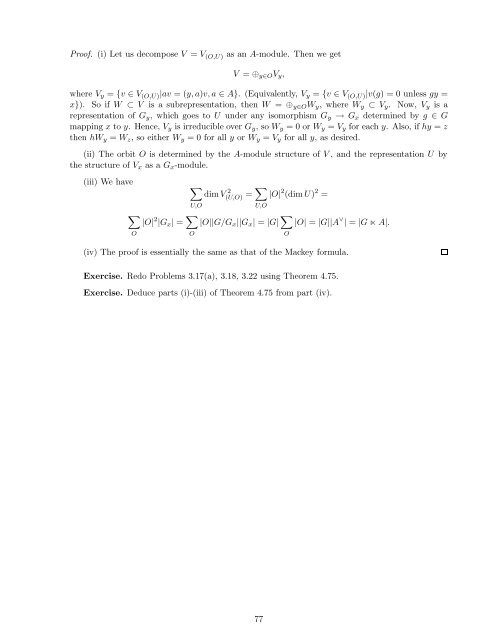Lecture notes for Introduction to Representation Theory
Lecture notes for Introduction to Representation Theory
Lecture notes for Introduction to Representation Theory
Create successful ePaper yourself
Turn your PDF publications into a flip-book with our unique Google optimized e-Paper software.
Proof. (i) Let us decompose V = V (O,U) as an A-module. Then we get<br />
V = yO V y ,<br />
where V y = {v V (O,U) |av = (y, a)v, a A}. (Equivalently, V y = {v V (O,U) |v(g) = 0 unless gy =<br />
x}). So if W → V is a subrepresentation, then W = yO W y , where W y → V y . Now, V y is a<br />
representation of G y , which goes <strong>to</strong> U under any isomorphism G y ⊃ G x determined by g G<br />
mapping x <strong>to</strong> y. Hence, V y is irreducible over G y , so W y = 0 or W y = V y <strong>for</strong> each y. Also, if hy = z<br />
then hW y = W z , so either W y = 0 <strong>for</strong> all y or W y = V y <strong>for</strong> all y, as desired.<br />
(ii) The orbit O is determined by the A-module structure of V , and the representation U by<br />
the structure of V x as a G x -module.<br />
(iii) We have<br />
<br />
dim<br />
2 V( U,O) = |O| 2 (dim U) 2 =<br />
U,O<br />
U,O<br />
<br />
|O|<br />
2 |Gx | = |O||G/G x ||G x | = |G| |O| = |G||A ∗ | = |G ∼ A|.<br />
O O O<br />
(iv) The proof is essentially the same as that of the Mackey <strong>for</strong>mula.<br />
Exercise. Redo Problems 3.17(a), 3.18, 3.22 using Theorem 4.75.<br />
Exercise. Deduce parts (i)-(iii) of Theorem 4.75 from part (iv).<br />
77

















